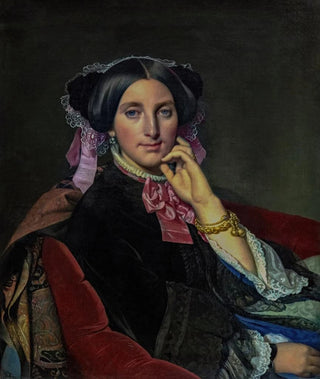Art print | Portrait of Madame Gonse - Jean-Auguste-Dominique Ingres


View from behind

Frame (optional)
The Portrait of Madame Gonse, created by Jean Auguste Dominique Ingres, is an iconic work of French neoclassicism, an artistic movement that champions harmony and idealized beauty. This painting, completed in 1852, depicts the artist's wife, a muse embodying both grace and sophistication of her era. Ingres, with his keen eye for detail and mastery of color, manages to capture not only Madame Gonse's physical appearance but also the very essence of her personality. This portrait is a true testament to the intimacy between the artist and his model, a frozen moment in time that evokes a deep emotional connection.
Style and uniqueness of the work
Ingres's technique is distinguished by its meticulous approach and attention to realism. In the Portrait of Madame Gonse, each brushstroke seems imbued with infinite delicacy, revealing the texture of the clothing and the luminosity of the model's skin. The choice of colors, subtly nuanced, helps create an atmosphere that is both intimate and majestic. Madame Gonse's slightly turned pose, along with her contemplative gaze, invites the viewer to ponder her thoughts and emotions. This painting is not limited to a simple representation; it transcends the classic portrait to become a true psychological work, where the character of the model is revealed through carefully orchestrated details.
The artist and his influence
Jean Auguste Dominique Ingres is a central figure in art history, recognized for his ability to fuse classical traditions with modern sensitivity. Trained at the Académie des Beaux-Arts, he developed a unique style that set him apart from his contemporaries. Ingres is often considered the last great master of neoclassicism, but his influence extends far beyond that period. His works inspired many 19th-century artists and beyond, notably the Impressionists, who admired his approach to drawing and composition. The Portrait of Madame Gonse, with its expressive richness and refined technique, bears witness to Ingres's enduring legacy, which continues to inspire admiration.

Matte finish

View from behind

Frame (optional)
The Portrait of Madame Gonse, created by Jean Auguste Dominique Ingres, is an iconic work of French neoclassicism, an artistic movement that champions harmony and idealized beauty. This painting, completed in 1852, depicts the artist's wife, a muse embodying both grace and sophistication of her era. Ingres, with his keen eye for detail and mastery of color, manages to capture not only Madame Gonse's physical appearance but also the very essence of her personality. This portrait is a true testament to the intimacy between the artist and his model, a frozen moment in time that evokes a deep emotional connection.
Style and uniqueness of the work
Ingres's technique is distinguished by its meticulous approach and attention to realism. In the Portrait of Madame Gonse, each brushstroke seems imbued with infinite delicacy, revealing the texture of the clothing and the luminosity of the model's skin. The choice of colors, subtly nuanced, helps create an atmosphere that is both intimate and majestic. Madame Gonse's slightly turned pose, along with her contemplative gaze, invites the viewer to ponder her thoughts and emotions. This painting is not limited to a simple representation; it transcends the classic portrait to become a true psychological work, where the character of the model is revealed through carefully orchestrated details.
The artist and his influence
Jean Auguste Dominique Ingres is a central figure in art history, recognized for his ability to fuse classical traditions with modern sensitivity. Trained at the Académie des Beaux-Arts, he developed a unique style that set him apart from his contemporaries. Ingres is often considered the last great master of neoclassicism, but his influence extends far beyond that period. His works inspired many 19th-century artists and beyond, notably the Impressionists, who admired his approach to drawing and composition. The Portrait of Madame Gonse, with its expressive richness and refined technique, bears witness to Ingres's enduring legacy, which continues to inspire admiration.






